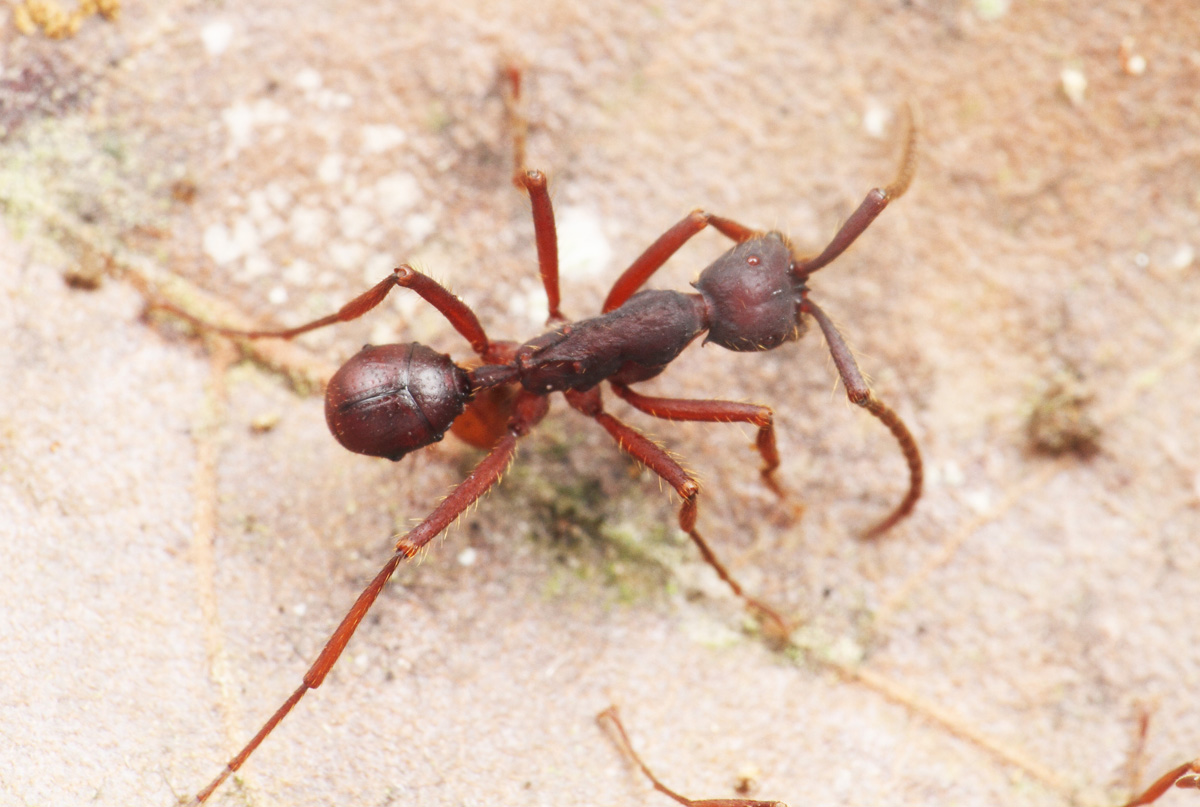- “From above it is difficult to detect the parasite, because the beetle closely resembles the ant’s abdomen,” von Beeren said in a statement. “When viewed from the side, however, it looks as if the ants had a second abdomen. To our surprise the odd looking ‘ant abdomens’ turned out to be beetles.”
- In a BMC Zoology article, von Beeren and his co-author, Alexey Tishechkin of the U.S. Department of Agriculture’s Systematic Entomology Laboratory, write that what they’d observed was an “exceptional mechanism of phoresy,” which is when two organisms form a symbiotic relationship in which one (in this case, the beetle) travels on the body of another.
- The new beetle, named Nymphister kronaueri after Daniel Kronauer, an army-ant researcher at The Rockefeller University in New York who first discovered the species, uses its strong mandibles to anchor itself to ants’ bodies during the nomadic army ants’ regular emigrations to new nesting sites.
Dr. Christoph von Beeren of Germany’s Technical University Darmstadt was collecting “ant guests” during the nightly emigration of an army ant colony at La Selva Biological Station, a lowland Atlantic rainforest in Costa Rica, when he and his colleagues realized that the abdomens of some of the ants looked odd.
The researchers used their headlamps to get a better look. “From above it is difficult to detect the parasite, because the beetle closely resembles the ant’s abdomen,” von Beeren said in a statement. “When viewed from the side, however, it looks as if the ants had a second abdomen. To our surprise the odd looking ‘ant abdomens’ turned out to be beetles.”
Von Beeren and his colleagues described the newly discovered beetle species that they had spotted catching a ride on the backs of army ants in an article published in the journal BMC Zoology yesterday.

“To the human eye, the beetle is quite difficult to detect when attached to the ant as they are similar in size and shape to the host ants’ abdomen,” von Beeren added. “The outer shell of the beetle is also smooth and shiny, just like the ants. We think that by imitating this part of the ants’ body they might reduce the chance of recognition by the ants, allowing the beetle to travel undetected.”
In the BMC Zoology article, von Beeren and his co-author, Alexey Tishechkin of the U.S. Department of Agriculture’s Systematic Entomology Laboratory, write that what they’d observed was an “exceptional mechanism of phoresy,” which is when two organisms form a symbiotic relationship in which one (in this case, the beetle) travels on the body of another.

Many other organisms, including additional species of beetles as well as flies, mites, silverfish, and wasps, are also known to exploit army ant colonies. These army ant-dependent species “often show astonishing adaptations such as chemical and morphological mimicry of ant workers, protective morphologies, as well as life history adaptations to the hosts’ life cycles,” the researchers write in the study.
The new beetle, named Nymphister kronaueri after Daniel Kronauer, an army-ant researcher at The Rockefeller University in New York who first discovered the species, uses its strong mandibles to anchor itself to ants’ bodies during the nomadic army ants’ regular emigrations to new nesting sites. N. kronaueri was only found hitching a ride on one particular army ant species, Eciton mexicanum, primarily on medium-sized workers, which von Beeren and Tisheckin say demonstrates that it is a highly specialized ant guest.
Neotropical army ant colonies cycle between stationary and nomadic phases, which last about three and two weeks, respectively, for ants in the Eciton genus, von Beeren and Tishechkin note in the study. A colony will stay at the same site during the stationary phase and emigrate to a new nest site every night during its nomadic phase.

Organisms that depend on ants for their own survival during at least part of their lifecycle are called “myrmecophiles” — which literally translates to “ant lovers.” “Since army ants are nomadic, myrmecophiles exploiting their societies share the need to track their host colonies during the frequent colony emigrations to new bivouac sites,” the researchers write. “They achieve this by riding on or being carried by the ants, or by walking independently on the ants’ emigration trail.”
The researchers collected ant parasites from many tropical sites while performing a biodiversity assessment of army ant guests at La Selva Biological Station, which led to the discovery of “numerous new species.” They say that there are likely many more myrmecophile discoveries yet to be made.
“Army ants have been studied extensively by researchers, yet this conspicuous new species has been overlooked until now,” von Beeren said. “Little is known about other species of army ants and their guest communities — it is evident that many more species like N. kronaueri still need to be discovered.”

CITATION
- Von Beeren, C. & Tishechkin, A.K. (2017). Nymphister kronaueri von Beeren & Tishechkin sp. nov., an army ant-associated beetle species (Coleoptera: Histeridae: Haeteriinae) with an exceptional mechanism of phoresy. BMC Zoology. doi:10.1186/s40850-016-0010-x